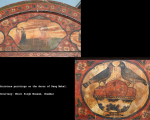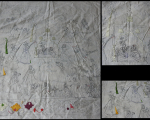Chamba rumal involves several arts in its making. The fabric, usually fine khaddar or muslin, is painted on by a miniaturist and embroidered by the embroidery artist, making it a collaborative effort. It is a folk style of embroidery that exists across Chamba and several other states of northern India in various forms that include coverings, patwars (belts), cholis, household accessories, chaupar (game of dice) cloth, wall hangings, chandwas (ceiling covers), and pankhas (fans). The miniature style rumals came to be in the late sixteenth to seventeenth centuries. The wide usage of this embroidery as dhaknu (square cover) and chhabu (circular cover) is probably why the craft is called rumal.
Chamba rumal is derived from the various schools of Pahari miniatures based on diverse themes, encompassing stories from the Gitagovindam, Ramayana, Mahabharata, Bhagavad Purana, and also incorporates themes based on royal life, such as shikargah (hunting), chaupar, and local tales and customs like the Minjar Mela Jalus (an annual fair), Gaddi Gaddan (Gaddis are a shepherding community of Chamba), Ved Vedi (wedding pavillion), Til Chauli (a traditional night-ceremony at Chamba weddings where women dance and sing; black sesame seeds [til] and rice [chaul] form an integral part of it), and so on.
One finds the natural life of Chamba with peacock, chakor, duck, parrot, swan, and musical instruments like dholak, dholakia, tanpura, veena, khartala, sitar as recurring motifs in the embroidery. The motifs bring out important elements of Chamba rumal and help enhance the mood of the stories depicted. This image gallery documents the evolution of the art work through time, the artists engaged in the work, motifs employed, and the tools and materials used to make the Chamba rumal, among other things.













